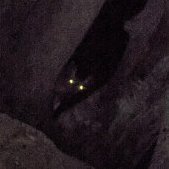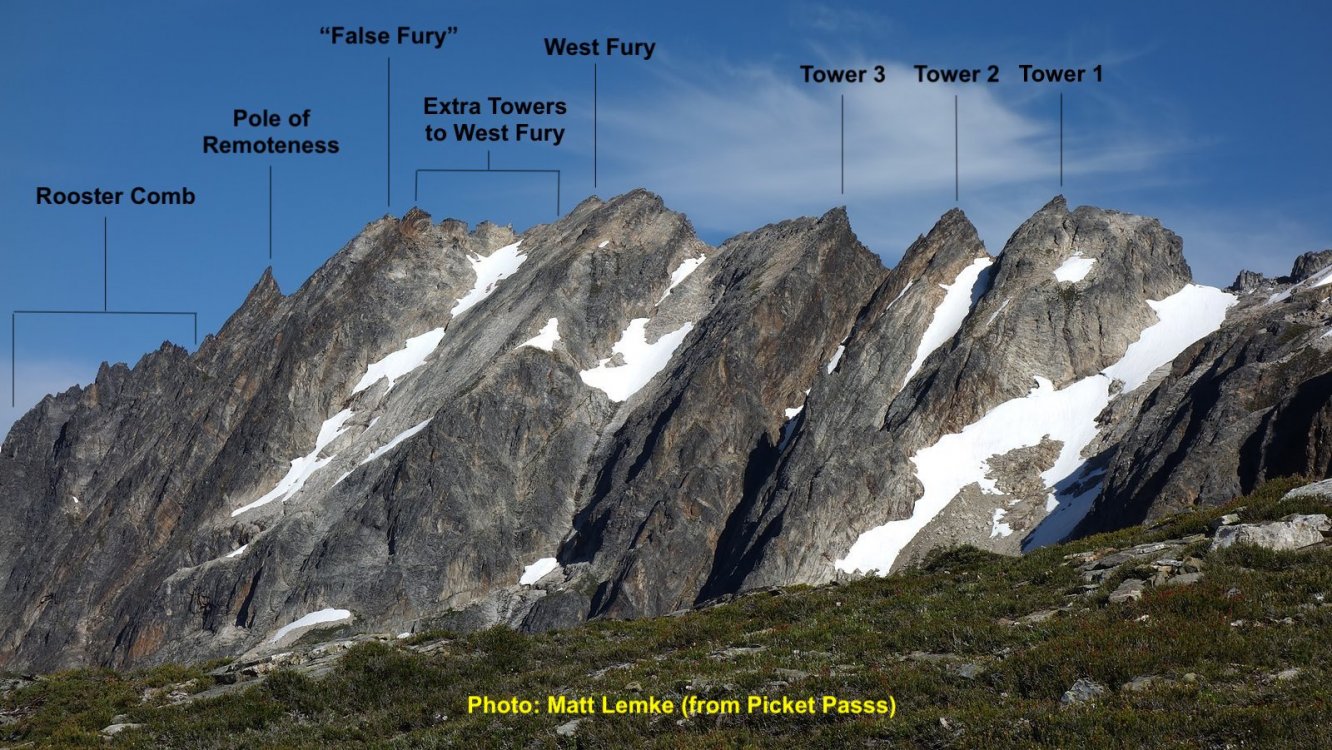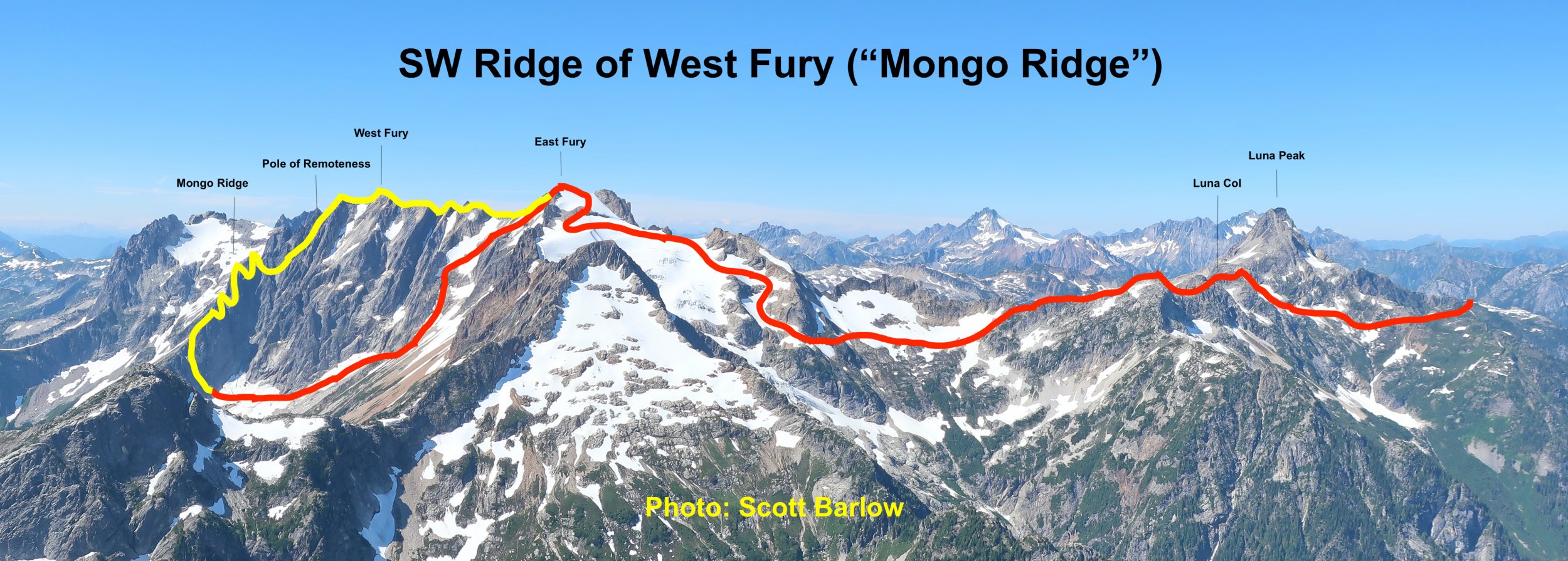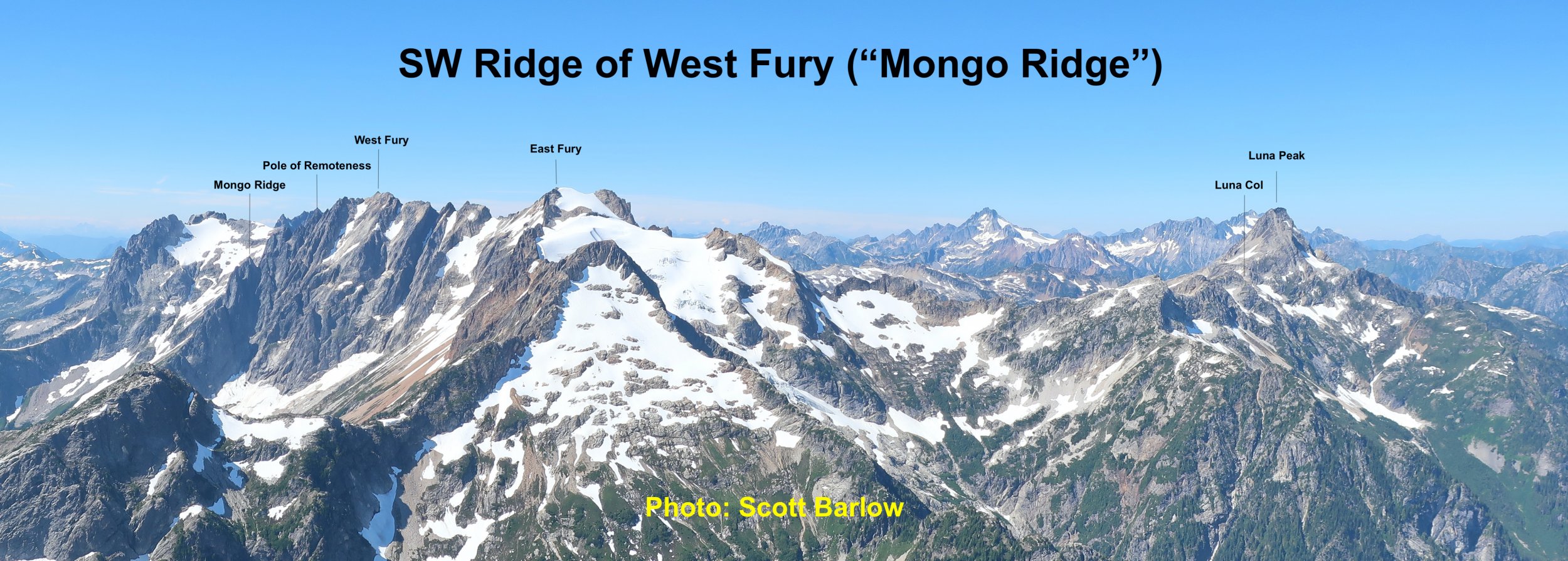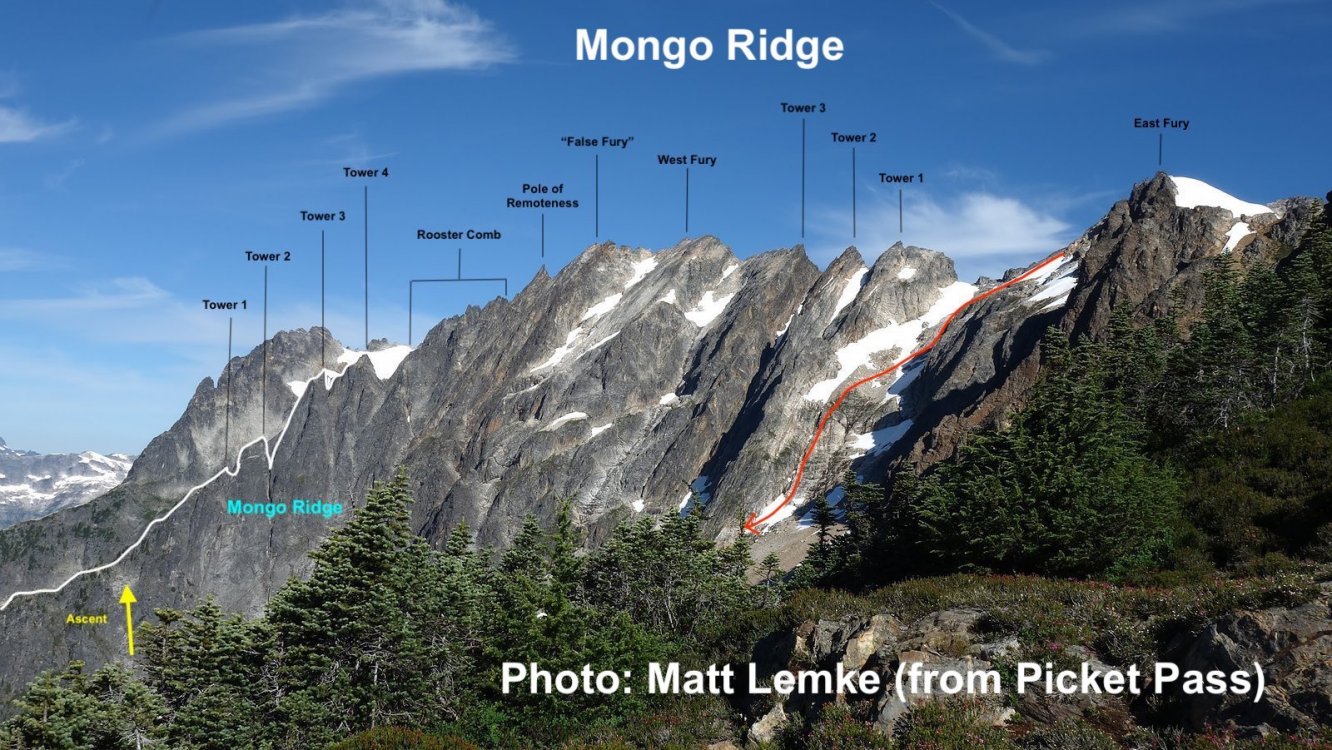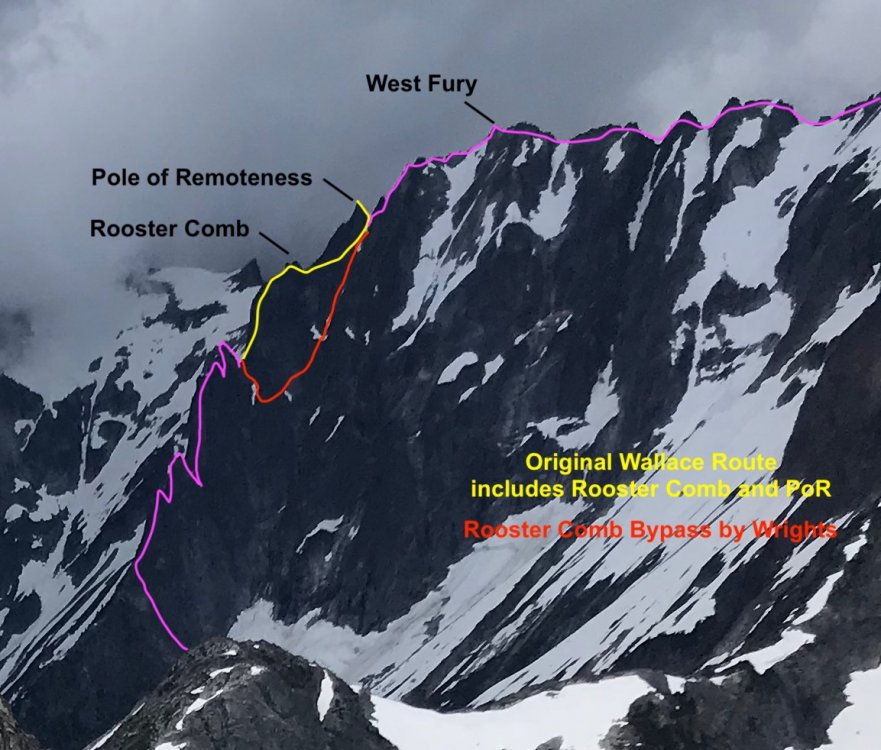Leaderboard
Popular Content
Showing content with the highest reputation on 07/12/21 in all areas
-
Trip: West Fury - Mongo Ridge Trip Date: 07/05/2021 Trip Report: In our relentless pursuit to ride the coattails of THE Wayne Wallace, Priti and I made the second ascent* of Mongo Ridge (the SW Ridge of West Fury in the Northern Pickets of the North Cascades). It is a Stegasaurus ridge which rises 4,000ft over a mile from Goodell Creek punctuated by thick clusters of gendarmes that look like they’re straight out of the Karakoram. [*2024 Update: Since our ascent, two more parties have ascended the SW Ridge of West Fury (total of four ascents as of July 2024, detailed below)] August 26-27, 2006: Mongo Ridge First Ascent Wayne Wallace (solo) making one bivouac past the Rooster Comb and Pole of Remoteness (with all of the route's technical climbing completed). Legend! https://waynewallace.wordpress.com/2014/05/ July 5, 2021: Jeff and Priti Wright make the Second Ascent of SW Ridge of West Fury, following Wayne's line of ascent but bypassing both the Rooster Comb and the Pole of Remoteness. They did not bring bivouac gear on route (bad call), and they did not make any bivouacs on route. Camp-to-camp in 23hrs from the summit of East Fury (base camp). July 11-13, 2022: Sam Boyce and Lani Chapko make the Third Ascent of the SW Ridge of West Fury, following Wayne's line of ascent, taking Jeff and Priti's Rooster Comb bypass, making the second ascent of the Pole of Remoteness (following Wayne's approximate 5.7 line), and making two biouacs on route (base camp at Luna Col). https://www.theclimbingguides.com/post/mongo-ridge-and-the-pole-of-remoteness-7-09-2022-7-14-2022 Early July, 2024: Emilio Taiveaho and Adam Moline make the Fourth Ascent of the SW Ridge of West Fury, following Wayne's line of ascent including the Rooster Comb (second ascent) and the Pole of Remoteness (third ascent, and by a new line of two pitches of 5.9R) making them the Second Complete Ascent of Wayne Wallace's Mongo Ridge! https://cascadeclimbers.com/forum/topic/107832-tr-mt-fury-wayne-wallace’s-mongo-ridge-second-ascent-of-the-rooster-comb-and-new-line-on-the-pole-of-remoteness-07072024/?fbclid=PAZXh0bgNhZW0CMTEAAaZGeT7NzsHS7Pk4D4-BEz-9Fi4D7NGD8mzAiVTHkasQ-41sIDl0dhUtNzM_aem_PLTVnZmmLRYxsTBP00Ynuw#replyForm We first heard about Mongo when Wayne came to speak for a BOEALPS - Boeing Employees Alpine Society Banquet in 2015 and regaled a captive audience with his bold adventures. We warmed up Wayne's feature presentation with a talk on our trip to Patagonia climbing Aguja de l'S. Then Wayne came on stage talking about Mongo, making de l'S look like a mole-hill. Wayne climbed this route in 2006 SOLO, like a boss, questing into unknown terrain that easily could have landed him into mandatory hard free climbing. With vertiginous cliffs on both sides, he knew that bailing from the route was not an option and that he had to climb whatever the mountain presented. The difficulties on the route were up to 5.9, with an additional 5.10b pitch (a routefinding error), but the towers presented possibilities up to 5.11 if we weren’t lucky enough to have Wayne’s beta. The first ascent is one of the legendary, mythical ascents of the Cascades and even of the climbing world. After 15 years, only a handful of folks to my knowledge have even considered attempting it again. The bottom half of the ridge has four narrow towers which require you to summit and rappel in order to make vertical progress on the ridge. Long, double-rope rappels and hard technical climbing discouragingly makes it take hours just to ascent 100ft at times. Above these four towers are the “Rooster Comb” and the “Pole of Remoteness” (named by John Roper who figured it was the hardest place to get to in the lower 48). After Tower 4 and before the Rooster Comb, we scramble traversed low around each of these features and did not summit the Pole of Remoteness since it was getting dark and we did not bring bivy gear. At Wayne’s suggestion, we planned to climb camp-to-camp which was situated at the summit of East Fury. This means that while we did ascend the topographic feature of Mongo Ridge to the summit of West Fury, we did not truly climb “Wayne Wallace’s Mongo Ridge” in the manner that he climbed, including many more pitches of technical terrain. When we talked to Wayne in 2019, I told him that “Somebody needs to repeat this route, just so the world can understand what you accomplished.” It’s impossible to understand the scale of this route without being on it, competing as “one of the largest features on any mountain anywhere.” “You have to climb a major mountain [East Fury] just to start a most major climb.” Even with Wayne’s pictures and descriptions, we were still filled with dread as we attempted to route-find up each tower. While I am proud of what we did accomplish, I am still shaken at the boldness and audacity of the first ascent. Our tale should be considered a celebration of that event. Wayne called it Alpine Grade VI, but Beckey downgraded it to V deeming it (incorrectly imho) similar in commitment to Slesse NE Buttress (ref. Cascade Alpine Guide Book 3, pg. 118). We concur with Wayne's Grade VI rating, although I won't be even slightly offended if anyone wants to challenge the grade while ensconced in sofa cushions. Our itinerary: -7/3/21: 2PM boat ride from Ross Lake Resort to Big Beaver TH. Bivy in Access Creek basin. -7/4/21: Access Creek Basin to East Fury Summit. Left summit bivy in situ. -7/5/21: 23hr day camp-to-camp including Mongo Ridge and the traverse from West Fury to East Fury. -7/6/21: East Fury to Access Creek Basin -7/7/21: Access Creek Basin to Big Beaver TH. 2:30PM boat back to RLR. Here are collected links regarding Wayne's FA, for reference: https://waynewallace.wordpress.com/2014/05/ http://www.alpinist.com/doc/ALP19/climbing-note-fury https://www.nytimes.com/2006/10/21/sports/othersports/21outdoors.html http://www.alpenglow.org/nwmj/07/071_Mongo.html http://publications.americanalpineclub.org/articles/12200713002?fbclid=IwAR0iS9vNBvJ1XUQPOTPIXy8eymiTsuWFHI5TJtuAvLJUNb5LknfgeYgTriI Scurlock Picture: https://www.pbase.com/nolock/image/65948954 I won't go through too much detail on our approach to Luna Col and East Fury, since it is detailed well in many other places: https://onehikeaweek.com/2020/08/02/mount-fury/ http://www.nwhikers.net/forums/viewtopic.php?t=8021967 (specifically useful here is the traverse from East Fury to West Fury) Since we planned to do the route camp-to-camp (situated on the summit of East Fury), we studied the traverse from West Fury to East Fury in detail since we figured we'd be onsighting it in the dark to get back to camp. I will point out the "Red Ledge" (pictured above) just past Luna Col is reached by staying directly on the ridgeline from the col to begin the traverse over to East Fury. Past the Red Ledge, the next tower (called "Crux Tower" in some reports) is ascended directly via 4th class ledges and short 5.4 steps. A rope and gear would not be useful here. There is significant foreshortening here, as the route looks much more accessible as you get closer. Unless you're climbing in Winter or Spring, you will not be able to get across the bergshrund (as shown in the Beckey overlay), but instead will traverse left then right to reach the summit arête. Furthermore, the approach to the base of Mongo Ridge from East Fury's summit as discovered by Wayne is the easiest approach. While it is possible to reach Mongo's base via Picket Pass (either by navigating over Outrigger Peak "Southeast Peak" or Otto-Himmel Col), these approaches would be significantly more effort...or bushwhack for days up Goodell Creek. As you approach, notice the grey washboard streak with an overhanging gully. The route will start to the right of this feature. The 4,000ft descent from East Fury's summit may involve a lot of slab if the snow levels are low. We regret not bringing bivy gear on route. An alternative itinerary could be: -Day 1: Big Beaver TH to Luna Col -Day 2: Luna Col to Mongo Ridge Tower 1. Option to leave stove and tent on East Fury Summit as you pass by. There are no good bivouac sites on route. Just bring a sit pad and a sleeping bag and open bivy if splitter forecast. -Day 3: Tower 1 to either East Fury or Luna Col. A note on weather: The Pickets have notoriously unpredictable weather. Even with a splitter forecast, you can still have rain or even storms. Consider a tarp as backup shelter. Crossing the moat is the first crux. The moat is huge! Only found one place where it touched the rock slightly. On the approach, don't come down anything you can't go back up! Here I had to cross a giant moat (unprotectable compact snow), using both Gully tools (then passed the tools down to Priti). A picket here would have been very useful...but that's a big cost. Might have to bury a tool and rap/swing across the moat. Tower 1 was a TIME KILLER! Wayne reported a 5.8 overhang crux which we did not find. Instead we got suckered into a runout 5.10b overhang in the grey washboard gully. Recommend future parties to avoid this gully completely, and instead stay on the face to its right. Our second mistake was getting suckered into a difficult 5.8 grassy gully. Wayne later clarified that he immediately captured the ridge first, then went straight up the ridge (recommended). We started in an obvious chimney (5.6), gaining the face on the left then going right (many variations). After the chimney, we went left to the 5.10b overhanging grey gully instead of going up. It looked harder to gain the face above, but it is 5.8 if you can find Wayne's Way. The slopes to gain the ridge are all STEEP. We breathed a sigh of relief once we were on situated on the upper slopes of Tower 1, but route finding continued to be a challenge. A 30m rappel took us down to the notch between Tower 1 and 2. It seems possible to bail here back down the glacier and back up to East Fury. Perhaps the last legitimate bail option, so we considered the time and knew we would be climbing through the night. Tower 2 is only 2 pitches of 5.7 with no real route finding difficulty and went pretty quickly. The rock is REALLY loose however, so I was careful not to knock anything down on my belayer. Route lines are all approximate by the way! The first double rope rappel from Tower 2 led to the notch between Tower 2 and Tower 3. Tower 3 is the technical crux of the route and another TIME KILLER! It takes hours just to gain 100ft elevation. Once atop, it's demoralizing to look down and see the top of Tower 2 so close. Wayne reported a 5.10a bulge which I think we avoided by staying on and just right of the ridgeline. From the notch between Towers 2 and 3, a 5.4 traverse gains a grassy belay with 5 more pitches above ( 5.9 30m, 5.9 30m, 5.9 30m, 5.9 50m, 5.6 65m). Priti stopped whenever she found a good belay spot. We also hauled packs on 4 pitches expecting 5.10a climbing at any moment. It was real 5.9 climbing, consistently on decent rock for four pitches. Next time, instead of hauling just load everything into the follower pack and leave the leader with a mostly empty backpack instead. We took two backpacks on this climb to evenly distribute weight and bulk while simul-climbing. This was a good method. We consistently trended right above the belay. Higher Hiiiiiigher Hiiiiiiiiiigher Another 60m rappel deposited us to the notch between Towers 3 and 4. Finally, we got through the technical crux and we were losing sun fast! We knew we were in for an open bivy or a heartbreaking omission of the Pole of Remoteness. Tower 4 is another quick one. Two pitches, 5.9 then 5.7. It looks like really hard climbing going straight up! Instead we followed Wayne's advice and traversed out right for ~20m on 5.9 terrain with decent protection, then up following flakes and grass to a good belay. As you start climbing up, the climbing doesn't ease up, but instead is engaging, fun 5.9. Then 65m simul-climb to the summit. A final 50m rappel down to the base of the Rooster Comb. We were a bit confused here since the terrain opened up into a minefield of gendarmes. The Pole of Remoteness was indistinguishable among all of the towers. We knew we had to boogie so we took all the shortcuts that we could find. We noticed that the Rooster Comb could be bypassed on the right on low-5th terrain by taking another 30m rappel, then down climbing and traversing its Eastern flanks to a grassy gully. Wayne went up and over the Rooster Comb, not realizing there was a bypass. The Rooster Comb is very complex with several small flagpoles that required rappels. Wayne describes the final rappel off the rooster comb as a "diagonal rappel" that you can redirect off of horns, after which he flicked the rope to retrieve. There are at least two more intermediate gendarmes between the Rooster Comb and the Pole of Remoteness that we skirted around. Wayne found himself on their left side while we were on their right side. Wayne captured the upper 4th class slopes via a grassy gully (shown above). From here it's all 4th class to the "False Fury" summit. I coin the label "False Fury" because we stared at this point almost along the entire route thinking it was the West Fury Summit, but instead is fairly far from the true West Fury summit. Above is pictured our Rooster Comb bypass route which required an additional 30m rappel (or easy down climb). This was the first time we encountered snow on route, but don't count on it being there! Bring 4L water each. Southern Pickets in all their glory. Wayne traversed around the right side of the Pole of Remoteness to reach the col and summit it from the backside. To climb it directly would probably be 5 pitches of hard, loose climbing. From the notch between "False Fury" and the Pole of Remoteness, Wayne reported 1 pitch of 5.7 to reach the summit of the PoR. There is no anchor on top, so he threw a rope around a loose block and solo downclimbed, using the rope as a backup. If you are a team, consider downclimb-belaying. We sadly felt the need to skip the pole since it was total darkness by the time we got to the notch with a lot of traversing left to go. Once atop "False Fury", we couldn't find the summit register and realized that the real West Fury was maybe .25miles away separated by 4 more gendarmes, first downclimbing (or rappelling) down and right and traversing around the first gendarme, then weaving up, over, and around the others to finally reach the real West Fury summit. Glad to have put in the time to memorize the traverse beta between West and East Fury, it went off slowly but smoothly. One piece of key beta was at the end of Tower 1 (the last tower between the Fury's), you can find a secret 4th class ramp around to the North (climber's left) to find the rappel station that leads to the final push up the slopes back to East Fury. This is a 30m rope stretcher rappel, by the way! Thanks to Wayne for all of your support and encouragement! I think this route is more of a classic in the way that Hummingbird Ridge is a classic. We should really just sit back and marvel at the first ascent. It's a true Picketeering adventure, but loose rock, lack of bail options, and lack of bivy sites is pretty discouraging. The Pole of Remoteness still needs a second ascent, however! But it would a pretty doable day to get to PoR in-a-day from your East Fury bivouac by traversing high along the ridge and scrambling down from "False Fury", then reversing the route. Gear Notes: Single Rack .1 to 2, doubles .3-.75, small cams (TCU 00, TCU0). We like small cams in the Pickets! Small rack of nuts. 1 screw and 1 V-threader for glacier (didn't use). 60m single rope, 60m pull cord (three long rappels + optional pack hauling), 1 Petzl Gully (technical light ice axe) each, 10 single alpine draws, 3 double alpine draws, 1 quad, 50ft 5mm cord for rap anchors (used it all), left three caribeeners on rappel stations, steel horizontal front-point crampons. Approach Notes: Boat from Ross Lake Resort to Big Beaver Creek - Access Creek - Luna Col - East Fury - 4000ft descent on South side - Mongo Ridge - West Fury - Easy Fury5 points
-
Trip: Monument Peak (8592'), Lake Mountain (8371'), Bird Peak (8330') - East Ridge Up, SE Ridge Down Trip Date: 07/03/2021 Trip Report: I climbed three peaks over the holiday weekend. Monument Peak (8592'), Lake Mountain (8371'), Bird Peak (8330') outside Mazama, Pistol Pass Approach. Started the climb from the Monument Creek Trailhead (Trail 484). The weather was looking perfect again and a holiday weekend, time for another east side climb. Headed out Friday night, caught some Zs at the Trailhead and headed out early Saturday morning. Saturday: I planned for 3 days as the trip is long with lots of climbing. I headed up Monument Creek Trail to the Eureka Creek ford to the Pistol Pass Trail and up the ridge. There used to be a bridge across Eureka Creek years ago but it came down and has not been replaced. There is a nice bridge base and a solid rock platform on the other side of the creek that is begging for a new bridge. Sure would do wonders for connecting the trails in the area for a nice big loop around the mountains of the area. The ford across Eureka Creek is not too bad, knee to mid-thigh deep depending on the crossing location. I found it easiest to cross a little way down the trail toward a rocky river bank. The Pistol Pass ridge trail is bone dry the whole way up. There is no water from Eureka Creek to Lake of the Woods Lake. I filled up with 3 liters of water at the creek and still had to travel about 2.5 hours without water before I got to Lake of the Woods to set up camp. The ridge is hot as hell when the sun is out, no place to hide and no water to cool off in. The trail up the ridge is hard to follow between 3900’ and 6000’, when in doubt stick to the ridge crest. Sunday: I Left Lake of the Woods Camp at 6:00am and climbed straight up a gully to a ridge line at about 7500’. I was thinking that the prominent rocky peak seen from Pistol Pass and the Lake area was Lake Mountain, it isn’t. It is an unnamed peak that is 40’ lower than Lake Mountain (which is to the north and is much easier to climb). This unnamed peak I am going to call Bird Peak (8330’) from here on out. I’m calling it Bird Peak because it kind of looks like a bird beak from one side and from the other side it looks like the mountain is flipping you the bird. Maybe it should be called Homonym Peak. Anyway, Bird Peak is a decent climb. It is a mix of 3rd, 4th and 5th class rock with an airy summit and room for one, maybe two people, to sit directly on the summit. Sitting on the summit of Bird Peak I realized that I was on the wrong summit and needed to climb Lake Mountain like originally planned. Lake Mountain is a basic class 2-3 scramble. Bird Peak is a much nicer peak. I headed down the ridge from Lake Mountain toward the Lake in the basin between Lake Mtn. and Monument Peak. Lots of water and camping spots in the basin. The ridge down from Lake Mountain to the basin is fairly steep with loose rock combined with slick rock sections. Not too fun but doable. From the basin Lake I climbed up toward the start of the East Ridge of Monument Peak. The East Ridge of Monument Peak is a mix of class 3 & 4 steep, loose, down slopping rock. Off the north side of the ridge is a sheer drop for several hundred feet. The first 100’ is the hardest part of the ridge and then it eases up a bit. With the loose, steep rock and the sheer drop, the pucker factor was at the high setting. I made it to the summit of Monument Peak about 3:00pm. Great views in all directions. I headed down the SE Ridge of Monument to return to camp. The SE Ridge is composed of tedious loose talus most of the way. When I reached the 7000’ mark on the SE Ridge I headed down the diagonal gully to the basin below. It’s loose shit rock all the way down to 6600’. From here I climbed back up and over the gully above Lake of the Woods and back to camp at about 9:00pm. A long day with lots of climbing and distance, my feet were done. Monday: I left Lake of the Woods Camp at 7:00am. I went back up and over Pistol Pass, down the ridge trail, through the Creek and back to the car at 3:30pm. Some Tips and Notes: Bring comfortable shoes, this is a long trip. I brought Hokas for the easy trail and creek crossing and mountaineering boots for the cross country and peaks. There is no water at all on the ridge between Eureka Creek and Lake of the Wood Lake. Bring as much water as you can carry from Eureka Creek. The trail up the ridge is hard to follow between 3900’ and 6000’, when in doubt stick to the ridge crest. The trail will fade in and out in that stretch. There are actually two lakes in the Lake of the Woods area, only the bigger lake is on the map. There is a smaller lake about a ¼ mile north of the main lake. There is a lot of water in the basin between Lake Mtn. and Monument Peak. A lake and several streams with good camping options. The East Ridge of Monument Peak requires your full attention. Class 3-4 steep, loose, down slopping rock. The gully to get onto and off of the SE Ridge of Monument Peak is not fun but it is the best option. Bottom is at about 6600’ and top is at 7000’. Travel Time for reference: Saturday: Car to Lake of the Woods Camp - 10.5 hours. Sunday: Camp to Summits back to Camp - 15 hours Monday: Camp to Car - 8 hours Elevation Gain for the trip: about 10,000’ Gear used: Whippet & Helmet Eureka Creek Ford at the top of Trail 484 Pistol Pass View - Bird Peak & Lake of the Woods down in the trees Lake of the Woods - Nice Camping. Bird Peak from ridge above Lake of the Woods Lake Mountain from summit of Bird Peak. Monument Peak - SE Ridge & East Ridge and Face Monument Peak - East Ridge Blackcap Mountain in the distance from the East Ridge of Monument Peak. Monument Peak Summit. View from Monument Peak. Looking down SE Ridge of Monument Peak. 6600' Access point of SE Ridge of Monument Peak. It's a lot steeper than it looks. Wear and Tear. One days worth of grippy rock climbing. Gear Notes: Gear used: Whippet, Helmet, Work Gloves. Bring lots of water carrying capacity, you will need it! Approach Notes: Monument Creek Trailhead (Trail 484) Start Location. Climb ridge trail to Pistol Pass.1 point
-
Trip: Goode - NE Buttress Trip Date: 07/02/2021 Trip Report: Ever since hiking over Park Creek Pass and seeing the true glory of the park, I've wanted to return and climb Goode. Albert and I hadn't seen each other since before the pandemic, and were stoked to get out on an adventure. On Monday, things weren't looking good. Seattle recorded its hottest day ever, and the temperature at the bivy was forecast to be 100 degrees Fahrenheit. By Thursday, however, the heat dome had dissipated, and an attempt seemed feasible. Our original 3-day plan was complicated by the washout of the North Fork Bridge. Instead of descending to the Park Creek Trail and returning to the Bridge Creek Trailhead via the PCT on day 3, we'd have to hike to High Bridge, take the bus to Stehekin, and hike back 17 miles via McAlester Pass on day 4. An hour-long line at Marblemount welcomed us on Friday morning, but we were able to get a cross-country permit no problem. The ranger told us that the bridge had just been repaired, so we reverted to our original 3-day plan. We left Bridge Creek at 9:30. We reached the turnoff for the North Fork trail at 1:30, and got a visual of the new bridge from atop the cliff. We optimistically believed that we'd be able to make the bivy by sunset, summit on Saturday, and return via the bridge on Sunday. Fording Grizzly Creek presented the first challenge. The creek crossed the trail at a point where the water seemed quite swift and deep. Luckily, the creek was broken up by islands of trees about a hundred feet downstream, and we were able to pick our way across knee-deep sections. Faffing about always takes longer than it seems. It took more than an hour to cross the creek, dry off, and get going again. We reached the North Fork crossing at 5:30. We were hoping that there might be logs conveniently laid across the creek, but the creek was raging everywhere up and downstream of the crossing. There appeared to be sections where we could definitely make it halfway across, but we were unwilling to traverse rapids of unknown depth beyond that. We debated putting on our harnesses and using rope tension to "rappel" across, as suggested in Blake's guide book, but neither of us had ever tried this technique. We were losing time and were exhausted. Even if we made it across, we and all of our gear would get wet, and we'd still have to climb 2000' to the bivy. We decided to hike another 1.5 miles upstream to the crossing described by Beckey. When we got there at 7:00, we found that the snow bridges had already melted out, and the creek was equally high there. We made the decision to bail. We bivied on an island of rock in the middle of the creek, gorged ourselves on our extra food, and limped back the next day. The next time I attempt Goode, I'll not underestimate the difficulty of the hiking, and will probably take an extra day for both the approach and the descent. Despite not even reaching the base of the climb, it was still an unforgettable experience. Gear Notes: Backpacking gear for 4 days. 60m half/twin rope. 5 cams 0.4"-2", nuts. Approach shoes for scrambling, trail runners for hiking. Approach Notes: Two high, swift water crossings (Grizzly Creek and North Fork). The Bridge Creek bridge has been repaired.1 point
-
I'm in awe and highly entertained. "Pole of remoteness", hah1 point

